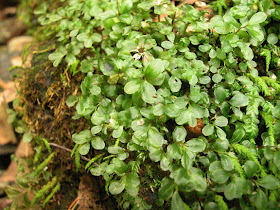it's a beautiful sunny day today so i went for a little hike and during that hike i was looking at the mosses on tree trunks as there's still so much snow on the ground.
i was thinking about ulota crispa and orthotrichum and how, when i first started mosses, i didn't know the difference between the two.
so i got out my camera and tried to get some shots from far away to close up of the two.
both were growing on the same big maple tree in my yard.
on a dry day, they are very easy to tell apart!
ulota crispa (like its name) has very 'crisped' and curly leaves when it's dry.
orthotrichum, on the other hand, has leaves that are straight and hug the stem.
so, on your next hike in the woods or on trees in your yard, see if you can find both species!
Sunday, March 10, 2013
Wednesday, March 6, 2013
The Mnium Group
then in 1968 T.J. Koponen separated them into different groups:
1) Leaf margin entire (or obscurely toothed): Pseudobryum, Cyrtomnium & Rhizomnium
2) Leaf margins with single teeth: Plagiomnium
3) Leaf margins with double teeth: Mnium
Let's take a look at the first group:
Rhizomniums are fairly common in our area, especially R. punctatum and R. appalachianum
Both species have leaves that have a strong border of long cells with interior cells that are roundish.
R. punctatum is much smaller than R. appalachianum and i find it most often on rocks in wet areas whereas R. appalachianum grows in wet, swampy soil.
 |
| Rhizomnium punctatum |
 |
| R. punctatum - note the smooth stems Rhizomnium punctatum also has no tomentum or brownish hairs growing up the stem; only at the base. |
 |
| a nice clump of Rhizomnium appalachianum |
 |
| a scan of R. appalachianum. notice how the stem is covered with brown 'stuff' covering the stem. |
 |
| Pseudobryum cinclidiodes, compare the leaf shape to R. appalachianum |
 |
| Cyrtomnium hymenophylloides |
